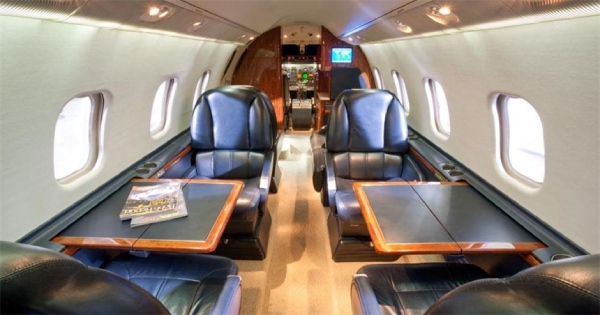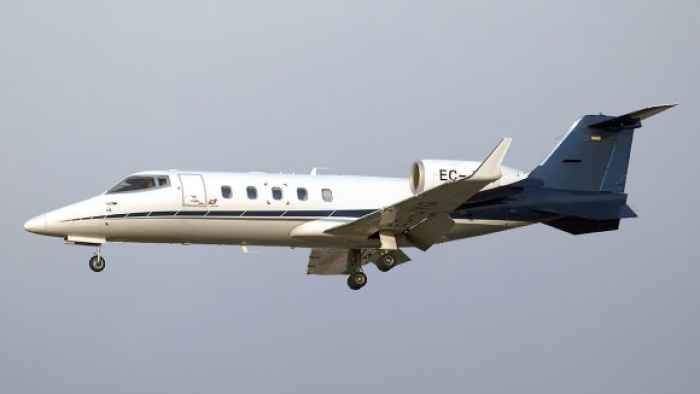Blog
Learjet 60
Slender, with incredible performance, this jet is the right choice for your next flight!
Do you often travel around the world to keep track of your business, and are you considering chartering a private jet?
And not just any aircraft, but one of the best among midsize jets, of the medium-sized aircraft that are recognized for their performance (and large cabin allowing you to stand), offering the best comfort to price ratio?
Then you are in the right place: after describing the features of the Hawker 800XP aircraft in the last article, we will cover all you need to know on the Learjet 60, one of the best mid-size business jets.
On board the Learjet 60: do you like to go fast?
The Learjet 60 is embodiment of speed: it can reach up to 840 km / h, and could easily compete with military super-planes. When it takes off, you will feel as if you've boarded a rocket heading for the Moon!
It can also reach an altitude of 51,000 feet, which is equivalent to over 15,000 meters. All this, with the best fuel consumption.
It consumes an average of 203 gallons of fuel per hour, the Learjet 60 has nothing to envy lighter, much smaller private jets.
The most noteworthy feature of the Learjet 60 is its amazing cruising performance: after reaching the cruising altitude, the aircraft can reach and maintain a speed of 457 knots (about 0.68 Mach).
Furthermore, this private jet has an intercontinental reach of 2,590 miles (or 2,250 nautical miles).
It comes as no surprise that many of the Learjet 60 trailing the skies are used not only by business men, but also by government and military representatives.
Let's explore its other features.
Learjet 60: An aircraft at the top
This aircraft is the successor of the Learjet 55, and like its predecessor, is manufactured by the Canadian company, Bombardier Aerospace.
An upgrade to the previous model, the Learjet 60 is equipped with:
- improved aerodynamics with the adoption of a longer fuselage,
- a more spacious cabin,
- engines capable of extraordinary performance (an updated model of Pratt & Whitney engines),
- improved efficiency and greater autonomy.
Production of the Learjet 60 first began in 1993, and ended in 2007 after having completed and delivered 316 aircraft. Currently, the price of a used Learjet ranges from 2 to 4 million dollars.
Every comfort at hand: do you wish to relax, even as you work?
The improved design of the Learjet 60 offers maximum comfort and a capacity of 7-8 first-class seats with ample legroom (plus 2 seats included, for the crew); and there are several retractable work surfaces.
The interior of the cabin comes in two models: Signature Series Red, and Black, both shades playing on soft color combinations and dark wood veneers.

The cabin’s lighting includes LED lights, and its insulation has been optimized. The aircraft is complete with a fully equipped kitchen, and a comfortable bathroom positioned in the tail.
Compared to the Learjet 55, from which the Learjet 60 originates, this updated version includes a cabin which, although not the largest in its class, is both significantly wider and improved.
The cabin management system was also overhauled, with the inclusion of control modules and compatible connectors for any type of device (both for the productivity, and entertainment of passengers on board).
The cabin was designed to take maximum advantage of space in the aircraft interior, one example is the "elbow" space now available to seated passengers.
Some features, such as retractable work tables, telephone, and radio, are standard; others, such as a fax machine, a coffee machine, and a microwave oven are optional.
Further improvements have been made to the hold, which has an increased capacity and can accommodate up to 6 large suitcases.
The performance of the Learjet 60
From an engine standpoint, the Learjet 60 is powered in strength by 2 Pratt & Whitney Canada PW305A turbofans.
The resulting performance, means this plane surely earns respect among others, particularly for take-off, during the ascent, and on the runway.
The two engines initially provide a nominal power of 4,600 pounds of thrust each, in order to reduce the take-off noise, but in flight they each supply 5,225 pounds.
With this, it was registered that the noise levels at the time of take-off reach 70.8 EPNdB, while in the landing phase, they reach 87.7 EPNdB.
Each function of the engines is electronically monitored by a FADEC (Full Authority Digital Engine Control) system, capable of automatically setting its performance throughout the entire flight: alleviating the pilot's workload decidedly.
On board the Learjet 60: here's what awaits you
Throughout the flight, the Learjet 60 performs fantastically.
Even as you travel through bad weather conditions and turbulent areas, you will cruise gracefully due to a strong pair of wings.
And while on the ground, the innovative steering system is activated in proportion to the speed of the front-placed wheel, and serves to make the jet much easier to maneuver.
The powerful wheel brakes are also of great help upon landing, and subsequently, in maneuvering on the runway.
To take off with this gem, a runway of just 5,450 feet is enough, less than 2 km, while to land without difficulty, it needs just 3,420 feet of track, about 1 km, no more.
These limits apply even at full capacity, both in fuel and in passengers on board.
The upward thrust will amaze you; this plane dashes into the sky with a single speed, contrary to other medium-sized jets, it can reach an impressive 40,000 feet in less than 20 minutes (and again, at full capacity).
Super technological avionics
In terms of avionics, this jet is equipped with the Integrated Pro Line 4 system, updated AHRS and FMS, improved MFD, electronic charts, optional XM weather radio and 3-rotor disc brakes that guarantee up to 600 perfect landings.
At its center, the jet is monitored by an IAPS (Integrated Avionics Processing System), which connects all the other flight systems and their related controls, and also contains the flight guide and the FMS, useful for short-range navigation.
This jet is additionally equipped, with a digital system for the automatic adjustment of pressurization within the cabin.
You must reach a certain altitude for your destination and, without the pilot intervening, the cabin pressure is controlled by the system.
The aerodynamics of the Bombardier Learjet 60
From an aerodynamic standpoint, its "ogive" wing is distinctive; but what is interesting to note is that the incredible speed of the Learjet 60 is precisely possible due to its aerodynamics.
How so? It's very simple: for the first time in the history of Learjet models, the computational fluid dynamics (CFD) program of NASA / Boeing Tranair was integrated.
This software is able to identify where the jet experiences a disproportionate resistance, and with that, can proceed to decrease approximately 4% of the total resistance.
The adjustment of the pressure occurs between the wing and the winglet, reducing the resistance, and in turn, resulting in an excellent overall efficiency.
Book your next flight now!
To summarize, the Learjet 60, with its medium-sized cabin, new engines that allow you maximum performance with little fuel consumption, the largest fuselage and the longest structure, the glass cockpit and much more, is a medium-range business jet offering the ideal solution for those looking for the perfect combination of comfort and power.
So, did you feel like trying this wonder of the skies?
Don't hesitate to contact us; we will provide you with all the information you need to plan your next trip on the Learjet 60.
If you prefer, you can also independently book your flight on fastprivatejet.com!
